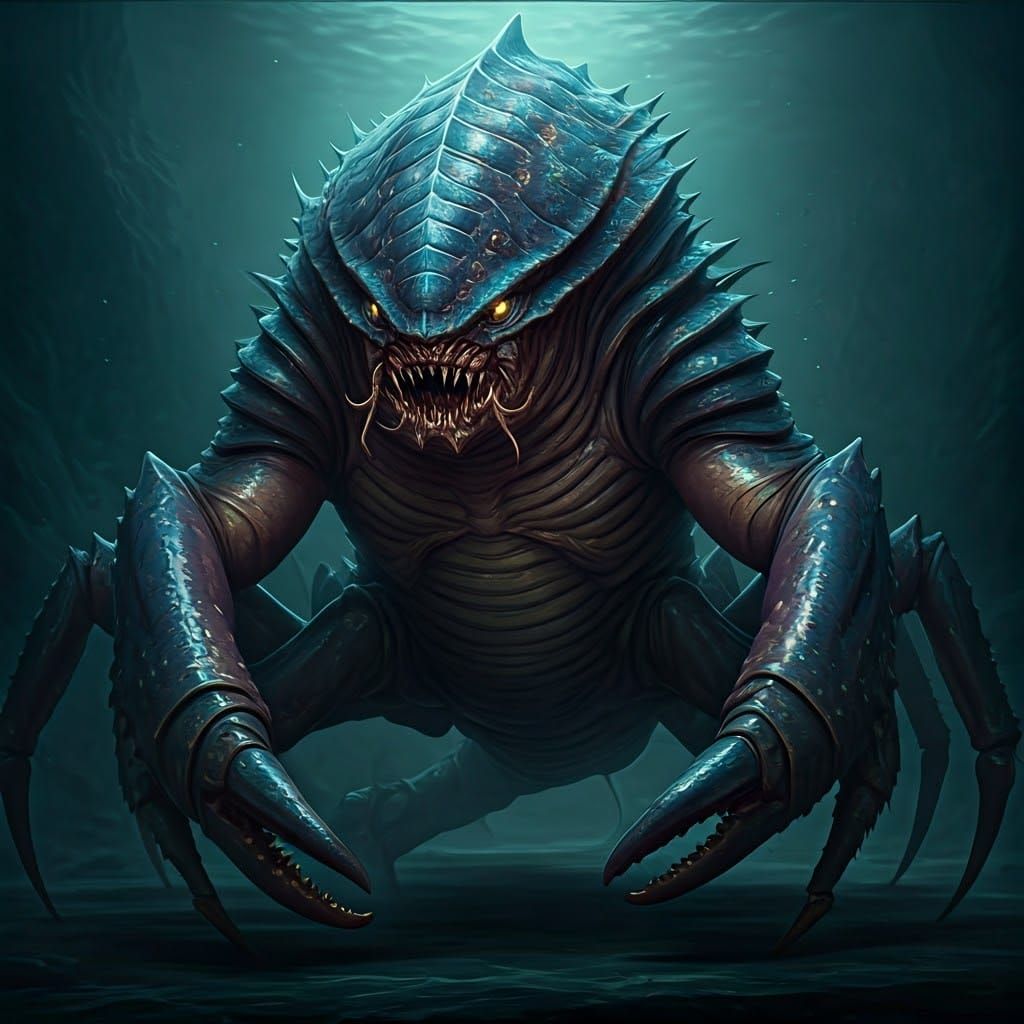
Scylla-Crawler
Large Aberration, Neutral Evil
Armor Class: 15 (Natural Armor)
Hit Points: 45 (6d10 + 12)
Speed: 30 ft. (land), 40 ft. (swim)
Challenge Rating: 2 (450 XP)
| STR | DEX | CON | INT | WIS | CHA |
|---|---|---|---|---|---|
| 16 | 14 | 15 | 1 | 12 | 1 |
Saving Throws: Strength +5, Dexterity +4
Skills: Perception +3, Stealth +4
Damage Vulnerabilities: None
Damage Resistances: None
Damage Immunities: Poison
Condition Immunities: Poisoned
Senses: Darkvision 60 ft., Passive Perception 13
Languages: Understands Deep Speech but cannot speak.
Spellcasting
“”
Actions & Abilities
Multiattack: The Scylla-Crawler makes three attacks: two with its Pincer Bite and one with its Tail Stinger. The attacks can be distributed among different targets or focused on a single target.
Pincer Bite: – Melee Weapon Attack: +5 to hit
– Range: 5 ft.
– Targets: One target
– Damage: 10 (1d8 + 3) piercing damage.
– Effect: If the target is Medium or smaller, it is grappled (escape DC 13). The Scylla-Crawler can grapple only one target at a time. While grappling, the target is restrained and takes 3 (1d6) piercing damage at the start of each of its turns until it escapes.
Tail Stinger: – Melee Weapon Attack: +5 to hit
– Range: 10 ft.
– Targets: One target
– Damage: 8 (1d6 + 3) piercing damage plus 4 (1d8) poison damage.
– Saving Throw: The target must succeed on a DC 13 Constitution saving throw or become poisoned for 1 minute. While poisoned, the target is incapacitated. The target can repeat the saving throw at the end of each of its turns, ending the effect on itself on a success.
Frightful Presence (Recharge 5-6): The Scylla-Crawler can unleash a terrifying shriek that echoes through the darkness, invoking the primal terror of the abyss. All creatures within 30 feet that can hear it must succeed on a DC 13 Wisdom saving throw or become frightened for 1 minute. A frightened target can repeat the saving throw at the end of each of its turns, ending the effect on itself on a success.
Sea Ambush: If the Scylla-Crawler is submerged in water or hidden amongst rocky terrain, it can use its action to perform a surprise attack on a target. If it successfully surprises a target, it gains advantage on its attack rolls against that target on the first turn of combat. If at least one attack from Multiattack hits during this surprise round, the target must succeed on a DC 13 Strength saving throw or be knocked prone, as the Scylla-Crawler pulls them to the ground with brutal efficiency.
Protective Shell (Recharge 6): The Scylla-Crawler can retreat into a defensive posture, curling its body and retracting its limbs for protection. Until the start of its next turn, it gains +5 to its Armor Class, and attacks against it must succeed on a DC 13 Dexterity saving throw to hit. On a failure, the attacking creature takes 5 (1d10) slashing damage from the Scylla-Crawler’s barnacle-like armor as they strike.
Swim and Strike: The Scylla-Crawler can swim rapidly through water and can move through difficult terrain without expending extra movement, allowing it to navigate rocky, submerged areas easily. If it moves through water, it can attack from any submerged position once per turn, striking with either its Tail Stinger or Pincer Bite as a bonus action after swimming up to half of its swim speed.
Appearance
-
Size and Shape: The Scylla-Crawler is a formidable creature, standing approximately 4 feet tall at the highest point of its segmented back while measuring about 7 feet long from snout to the tip of its whip-like tail. Its body is robust and muscular, showcasing a blend of predator and ambush designs, with a hunched posture that aids in its stealthy approach.
-
Coloration: The creature sports an iridescent carapace that shifts between deep oceanic blues and dark purples, mimicking the colors of its underwater surroundings to enhance its camouflaging abilities. The barnacle-like armor encrusting its body glints with damp, reflective properties as light hits it, further adding to its spectral appearance.
-
Texture and Surface Features: The surface of the Scylla-Crawler is a complex blend of textures; parts are smooth and glossy, while others are rugged and barnacle-ridden. The streamlined areas around its limbs and tail are slick, helping it navigate through water seamlessly, while the armor plating harbors the roughness of stones and debris encountered in its tidal territory.
-
Facial Features: Its face features a gaping maw lined with serrated teeth, each one capable of rending flesh. The glowing yellow eyes are piercing and predatory, set within a shark-like visage that inspires fear. Long, curved antennae extend from above its eyes, sensitive to vibrations in the surrounding water, providing heightened awareness and helping it detect approaching threats or prey.
-
Limbs and Appendages: The Scylla-Crawler boasts four powerful crab-like legs, each terminating in razor-sharp pincers that are not only great for grappling but also serve as formidable weapons when slashing at foes. The two larger pincers are coiled up menacingly near its body, displaying an array of deadly spikes. Additionally, its long, whip-like tail arches high, armed with a barbed stinger capable of delivering venomous strikes, enhancing its threat level significantly.
-
Special Features: The phosphorescent glow emanating from the end of its tail is not merely for show; it serves both as a lure for unsuspecting prey and as a means to intimidate would-be challengers. Its carapace carries faint markings resembling ancient sigils, thought to be remnants of the sea sorceress’s magic imbued within the creature.
-
Posture and Movement: The Scylla-Crawler adopts a hunched posture, presenting a silhouette that blends into the environment, ideal for ambush tactics. Its movement is a deceptive mix of grace and aggression; while it can scuttle with unsettling speed across rocky surfaces or through water, it also maintains an eerie stillness, waiting for the perfect moment to strike.
-
Additional Notable Traits: The Scylla-Crawler’s body is layered with natural armor plating resembling embedded coral and barnacles, providing significant defense against physical attacks. The sporadic bioluminescent patterns flickering across its carapace are suggestive of its magical origin, giving the creature an otherworldly presence that is as mesmerizing as it is deadly.
Tactical Information
Tactical Information for Scylla-Crawler Combat Behavior
Combat Behavior:
Ambush Predator:
The Scylla-Crawler relies on stealth and surprise, often choosing rocky terrain, shallow water, or the murky shadows of underwater debris as its hunting ground. During combat, it will employ the following tactics:
-
Stealthy Approach: At the start of combat, the Scylla-Crawler will attempt to hide in its environment, rolling for Stealth with advantage. It will watch for the right moment to strike, prioritizing the most vulnerable target within the party.
-
Initiate Surprise Attack: If successful in remaining hidden, the Scylla-Crawler gains a surprise round, allowing it to launch its multiattack against an unsuspecting foe, utilizing its Pincer Bite and Tail Stinger attacks in the first round. This can swing the momentum in its favor if it can grapple and poison a target before they can react.
-
Grappling Tactics: Once a player is grappled, the Scylla-Crawler will prioritize maintaining the grapple. It will focus on using its tail stinger on the grappled target, maximizing its damage output while simultaneously preventing that character from escaping easily.
-
Hit-and-Run Tactics: If the Scylla-Crawler is injured or outnumbered, it will use its superior swimming ability to dart away into deeper waters or rocky outcrops, creating distance to regroup. It may ambush again after retreating, waiting for the party to lower their guard.
-
Team Coordination: In groups, Scylla-Crawlers will coordinate their movements to encircle prey. By using flanking tactics, they gain advantage on attack rolls against isolated targets. Communication through subtle sensory cues (via their antennae) will help them execute strategic plans.
Narrative Interactions:
When interacting with characters or players through narrative means, the Scylla-Crawler’s behavior can be as tactical and cunning as in combat:
-
Terrifying Presence: When players first encounter the Scylla-Crawler or hear its ominous thrumming in the water, they might experience an increasing sense of dread, especially if they are on the edge of the water or exploring coastal caves. Descriptive storytelling can enhance the fear factor as they hear the rattling of its pincers and see glimpses of its glowing eyes beneath the dark waves.
-
Luring Foes: The Scylla-Crawler may use its intelligence (though limited) to manipulate its surroundings. It could knock over debris near adventurers to draw attention, then strike from a concealed position. Such tactics showcase its ability to outsmart its prey, staying true to its nature.
-
Symbol of a Greater Threat: The arrival of a Scylla-Crawler can serve as a foreshadowing for greater evils lying in wait. If players discover carcasses of sailors or fish ruined by poison trails, this could be a portent of the sorceress’s influence in the area, keeping their guard up and making them aware that greater dangers await.
-
Use of the Environment: If the Scylla-Crawler has the upper hand in controlling the environment (for example, during heavy rain or stormy tides), it might manipulate the terrain to create cover for itself. During encounters, describe how waves crash or how the shadows stretch longer, obscuring their view and allowing the creature to camouflage effectively.
-
Post-Battle Clues: After a battle, remnants of magical energy or the essence of ancient sea secrets could linger around, hinting at the Scylla-Crawler’s connection to the sorceress or the dark deities it serves. This can lead to further exploration or whisperings of deeper secrets tied to the Oozing Abyss.
Conclusion:
These tactical behaviors and narrative cues collectively enhance the immersive experience surrounding the Scylla-Crawler. They articulate its cunning and danger not only as a physical threat but also as an agent of a larger menace, encouraging dynamic storytelling and acute player engagement.











